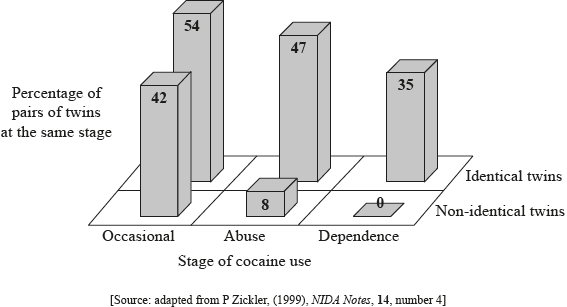| Date | November 2013 | Marks available | 3 | Reference code | 13N.3.HL.TZ0.4 |
| Level | Higher level | Paper | Paper 3 | Time zone | TZ0 |
| Command term | Analyse | Question number | 4 | Adapted from | N/A |
Question
A study was conducted into the influence of genetic factors on occasional cocaine use, abuse and dependency. Pairs of female twins were interviewed to determine if either or both of them had used cocaine at all and also whether they had become abusers of cocaine or dependent upon it. Abuse was diagnosed if cocaine was having harmful consequences on the life of the person and dependence by signs that the person would suffer withdrawal symptoms without it. For each of these three stages of cocaine use, concordance rates were calculated for both identical and non-identical twins. The concordance rate is how many pairs of twins are both at a particular stage, expressed as a percentage of the total number of pairs in which either or both are at that stage. The bar chart shows the results.

Identify which stage of cocaine use shows the least percentage difference between identical twins and non-identical twins.
Compare the results for identical twins and non-identical twins.
Analyse the data to find whether it supports the hypothesis that genetic factors cause some people to have a much higher chance of cocaine dependence than others.
Markscheme
occasional
both (identical and non-identical twins) show lower percentages going from occasional to abuse to dependence;
at every stage, the percentage is higher for identical twins;
non-identical twins percentage drops to zero for dependence (but identical twins does not);
difference is similar for both groups between abuse and dependence;
sharper decrease between occasional and abuse for non-identical twins than identical twins/OWTTE;
Do not accept answers stating numerical values only
hypothesis supported as identical twins are more likely to behave the same for abuse and dependence than non-identical twins;
identical twins have the same genotype / OWTTE;
hypothesis not supported as environment is the major factor for trying cocaine;
not known if similar results may be due to similar environment;
not enough data for valid statistical analysis/OWTTE;
Examiners report
Most identified ‘occasional’ as the stage showing the least difference between the two types of twins. The comparison of results was a bit more difficult, although most gained some marks; many did not understand that these were concordance rates rather than percentages of use. Some candidates stated numerical values only instead of stating the relationship between values in their comparisons, gaining no mark. The analysis was sometimes laborious, but most could see the differences between the two types of twins as a supporting evidence for genetic factors; statements about evidence for environmental factors were scarce.
Most identified ‘occasional’ as the stage showing the least difference between the two types of twins. The comparison of results was a bit more difficult, although most gained some marks; many did not understand that these were concordance rates rather than percentages of use. Some candidates stated numerical values only instead of stating the relationship between values in their comparisons, gaining no mark. The analysis was sometimes laborious, but most could see the differences between the two types of twins as a supporting evidence for genetic factors; statements about evidence for environmental factors were scarce.
Most identified ‘occasional’ as the stage showing the least difference between the two types of twins. The comparison of results was a bit more difficult, although most gained some marks; many did not understand that these were concordance rates rather than percentages of use. Some candidates stated numerical values only instead of stating the relationship between values in their comparisons, gaining no mark. The analysis was sometimes laborious, but most could see the differences between the two types of twins as a supporting evidence for genetic factors; statements about evidence for environmental factors were scarce.

